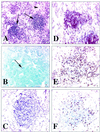Temporal and spatial arrangement of lymphocytes within lung granulomas induced by aerosol infection with Mycobacterium tuberculosis
- PMID: 11179349
- PMCID: PMC98078
- DOI: 10.1128/IAI.69.3.1722-1728.2001
Temporal and spatial arrangement of lymphocytes within lung granulomas induced by aerosol infection with Mycobacterium tuberculosis
Abstract
The progression of the immune response in the lungs after aerosol infection with Mycobacterium tuberculosis is a complex cellular event dominated by macrophages and lymphocytes. Although the phenotype of lymphocytes participating in this response is becoming increasingly well characterized, the dynamic influx of these cells during the infection and their spatial arrangements within the lung tissue are still poorly understood. This study shows that in the first month after aerosol infection with M. tuberculosis there was a steady increase in the percentages of total CD3+, CD3+ CD4+ and CD3+ CD8+ cells, with consistently larger numbers of CD3+ CD4+ cells than of CD3+ CD8+ cells. As granuloma formation continued, the granuloma was found to consist of macrophages, CD4, and CD8 T cells, as well as a smaller number of B cells. Whereas CD4 T cells formed organized aggregates, CD8 T cells were fewer and more scattered and tended to be more prominent toward the periphery of the granulomas. The possible ramifications of the juxtapositions of these two major T-cell subsets are discussed.
Figures





References
-
- Bosio C, Gardner D, Elkins K L. Infection of B cell-deficient mice with CDC1551, a clinical isolate of Mycobacterium tuberculosis: delay in dissemination and development of lung pathology. J Immunol. 2000;164:6417–6425. - PubMed
-
- Cardona P J, Cooper A M, Luquin M, Ariza A, Filipo F, Orme I M, Ausina V. The intravenous model of murine tuberculosis is less pathogenic than the aerosol model owing to a more rapid induction of systemic immunity. Scand J Immunol. 1999;49:362–366. - PubMed
-
- Caruso A M, Serbina N, Klein E, Triebold K, Bloom B R, Flynn J L. Mice deficient in CD4 T cells have only transiently diminished levels of IFN-γ, yet succumb to tuberculosis. J Immunol. 1999;162:5407–5416. - PubMed
-
- Cooper A M, Callahan J E, Keen M, Belisle J T, Orme I M. Expression of memory immunity in the lung following re-exposure to Mycobacterium tuberculosis. Tubercle Lung Dis. 1997;78:67–73. - PubMed
Publication types
MeSH terms
Grants and funding
LinkOut - more resources
Full Text Sources
Research Materials

